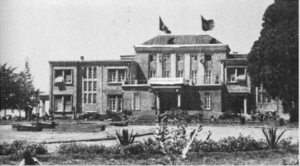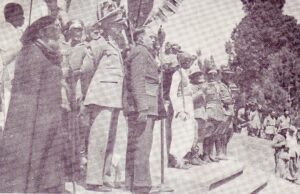
On Yekatit 12
Comrades, today is the day when we should show our devotion to our viceroy by reacting and destroying the Ethiopians for three days. For three days I give you carte blanche to destroy and kill and do what you wan to the Ethiopians. —Federal Secretary Guido Cortese
On 19 February, which is Yekatit 12 in the Ethiopian calendar, against the backdrop of the Italian invasion and crushing of the Ethiopian military, Italian Marshal Rodolfo Graziani decided to distribute alms to the Addis Ababa locals to celebrate the birth of the Prince of Naples at the “Little Ghebi” Palace (now the the Addis Ababa University Building).

Two disaffected Eritrean students, Abraha Deboch and Mogus Asgedom, had been searching for a moment to strike against the Italian invaders. Deboch himself was actually employed by the Fascist Political Bureau of the invading Italians, but had turned into a double agent over a year before, but had thus far been limited to sharing information.
The two decided to act while the hated Graziani was preening in front of the begging crowd, and at 11 am on 19 February they began lobbing grenades before escaping into the crowd and being spirited away by the taxi driver Simeyon Adefris.

The grenades did not kill any Italians, although Graziani was in the path of a large amount of shrapnel and had to be rushed to the hospital in a coma for immediate surgery. He survived. But the soldiers protecting the Italian elite acted immediately and started firing into the crowd. The firing never stopped.
For the next three days, witnesses said that literal rivers of blood flowed down the streets of Addis Ababa, as Italian soldiers and colonial Askari troops threw themselves into the slaughter. The most common methods of killing Ethiopians was hanging or shooting them, but there were also more horrific methods employed; as the Hungarian Dr. Ladislav Sava reported about people being burned alive in their huts, children being mercilessly tossed back inside to suffer along with adults, “Great flames from burning houses illuminated the African night.”
More than 19,000 Ethiopians, 20% of the Addis Ababa population, were murdered in three days.

Earlier orders made the expected behavior of the Italian and colonial troops clear, as Graziani urged them not to have “false pity” when he awoke from his coma.
“You are to punish without pity all persons found in possession of arms and ammunition. I instruct you to burn not only their houses, but also the persons themselves,” said the Residente of Bahir Dar, Captain Corvo.
The greatest slaughter began after 6:00 in the evening. During that awful night Ethiopians were thrust into lorries, heavily guarded by armed Blackshirts. Revolvers, truncheons, rifles, and daggers were used to murder completely unarmed black people, of both sexes and all ages. Every black person seen was arrested and bundled into a lorry and killed, either in the lorry or near the Little Ghebi, sometimes at the moment when he met the Blackshirts. Ethiopian houses and huts were searched and then burnt with their inhabitants. To quicken the flames, benzine and oil were used in great quantities. The shooting never ceased all night, but most of the murders were committed with daggers and blows with a truncheon at the head of the victim. Whole streets were burned down, and if any of the occupants of the houses ran out from the flames they were machine gunned or stabbed with cries of “Duce! Duce! Duce!” From the lorries in which groups of prisoners were brought up to be murdered near The Ghebi, the blood flowed onto the streets and again from the lorry we heard the cry, “Duce! Duce! Duce!” —Dr Ladislav Sava
The occupying troops especially sought out the educated and noble classes of Ethiopians in their murder spree during the three days; a planned attempt to make sure that there was no one with the background necessary to rally the occupied nation in the future.
As the slaughter slowed, the two young men who had started the murder into motion were themselves murdered by Gojjam locals as they tried to escape the searches of the Italian military. The taxi driver, Simeyon Adefris, was discovered and tortured to death.
Few outside Ethiopia remember the horrendous massacre that killed 20% of the Ethiopians in Addis Ababa on 19 February 1937, but it is still solemnly commemorated in Ethiopia on Yekatit 12 – the massacre’s local anniversary. A monument, prominent in Addis Ababa, was donated in 1955 by Marshal Tito of Yugoslavia in acknowledgment of the enormous World War II death tolls in two countries often forgotten by by the larger powers of the world.
To read more about the history of Ethiopia, please click here.
- February 19, 2021
- History
